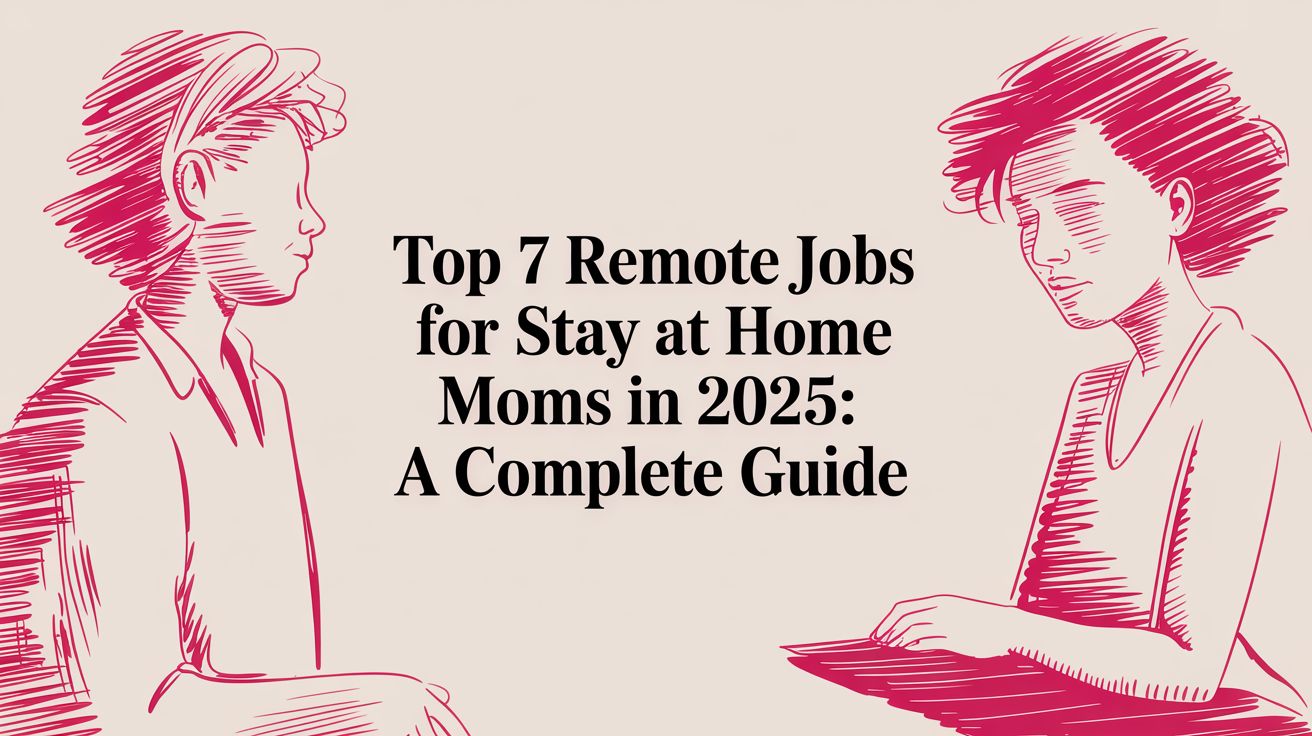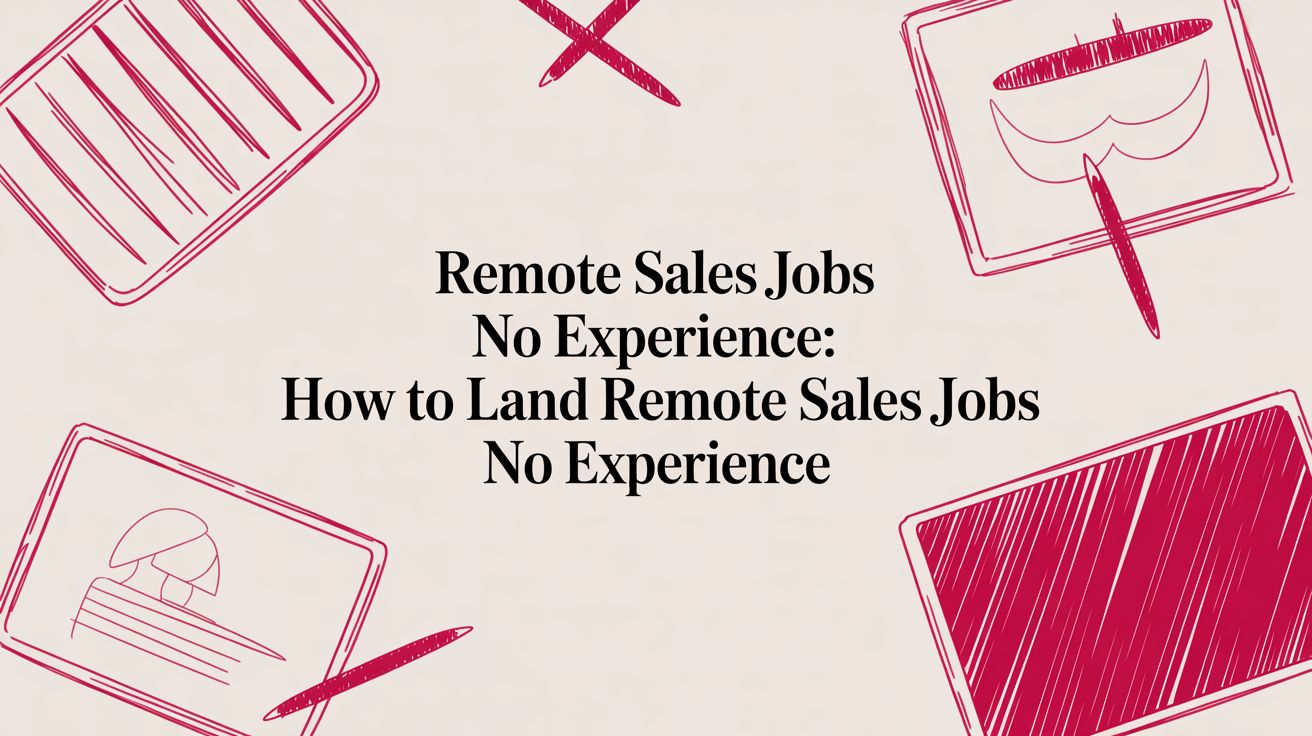How to Set Boundaries at Work and Reclaim Your Life
Max
Setting clear boundaries at work is all about drawing a line in the sand. It’s about defining your limits—what you will and won’t do—and then clearly communicating them to protect your time, energy, and sanity.
This means having the confidence to say “no” to things that fall way outside your job description, actually disconnecting when the workday is over, and fiercely protecting your personal time from work-related creep. Think of it as building a sustainable framework for your entire professional life.
Why Your Work-Life Balance Feels Broken

It almost always starts small. A single “harmless” request to check an email after dinner. A quick weekend call about something that wasn’t really an emergency. Before you know it, these little compromises pile up, and the line between your professional and personal life gets so blurry it practically disappears.
This isn’t some personal failing on your part. It’s a classic symptom of today’s always-on work culture.
With the explosion of remote work and globally distributed teams, someone, somewhere, is always online. This creates a silent, creeping expectation that you should be, too. The clear end-of-day signal we once had is gone, replaced by a fluid transition that makes it harder than ever to truly switch off.
The Slow Creep of Burnout
This constant connectivity isn’t just a feeling; it has a real impact. Worldwide, only about 60% of employees feel they have a healthy handle on their work-life balance. Since 2020, daily use of tools like Microsoft Teams has jumped by nearly two hours for some, which lines up with 37% of users reporting burnout symptoms.
These aren’t just abstract stats. They represent a widespread, collective struggle. The pressure to be perpetually available and productive eats away at the downtime we desperately need to recover.
This leads to some pretty predictable outcomes:
- Chronic Stress: That low-grade, humming anxiety of never feeling truly “off the clock.”
- Reduced Focus: When work bleeds into your personal time, your brain struggles to concentrate fully during actual work hours.
- Strained Relationships: Your personal life—friends, family, hobbies—constantly gets pushed aside for “one last thing” for work.
If this sounds painfully familiar, looking into some gentle, supportive ways to improve your work-life balance can be a powerful first step toward getting your peace back.
The real problem is that weak boundaries don’t just invite more work; they send a signal that your personal time is up for grabs. Whether you mean to or not, this sets a precedent that can be incredibly difficult to undo later on.
Just recognizing these patterns is a huge step. Sometimes, just tweaking how you approach your tasks can make a difference, and you might find some useful ideas in our guide on how to improve workplace efficiency. In the sections ahead, we’ll get into the specific, actionable strategies you can use to build—and maintain—the boundaries you need.
Defining Your Personal and Professional Non-Negotiables

Before you can even think about defending your boundaries, you have to know where they are. This isn’t about some vague notion of “work-life balance”; it’s about drawing specific, concrete lines that you’re unwilling to let work cross. Think of it as creating a personal rulebook for your professional life.
This whole process kicks off with some honest self-reflection. You need to get real about what truly matters to you, what sucks the life out of you, and which parts of your personal life are absolutely sacred. Only then can you build boundaries that feel authentic and, more importantly, sustainable.
Identify Your Core Values and Priorities
Your non-negotiables are always rooted in your core values. Is it family time? Creative freedom? Mental peace? Pinpointing these helps you understand why a certain boundary is so important, which makes it a whole lot easier to stick to your guns when you’re challenged.
Start by asking yourself some direct questions:
- Time Boundaries: What’s the absolute latest I’m willing to handle a non-urgent request? Am I ever okay with weekend work, and if so, under what very specific circumstances?
- Workload Boundaries: How many high-priority projects can I realistically juggle without the quality of my work—or my well-being—taking a nosedive?
- Communication Boundaries: Is it okay for people to expect instant replies from me on Slack, or do I need dedicated blocks of “do not disturb” time to actually get work done?
Answering these questions gives you a clear map of your limits. It takes the fuzzy concept of setting boundaries and turns it into a tangible set of rules you can follow and eventually communicate to others.
Define Your Absolute Limits
Everyone has hard lines that simply should not be crossed. These are your absolute limits—the commitments and personal needs that are completely off-limits to work.
Your boundaries are not static walls; they are dynamic guidelines that define your relationship with work. They require periodic re-evaluation to ensure they still serve your well-being and professional goals.
And you know what? Your needs will absolutely change over time. Research on boundary management found that a whopping 39% of professionals either wanted to or actively did make changes to their work-life boundaries. This just shows how fluid these limits can be and that setting them is an ongoing process of adjustment based on where you are in life and your career.
Defining these non-negotiables even extends to your physical environment and how you show up, especially when working from home. For many of us, that means finding the best work-from-home clothes that master the fine line between comfort and a polished look to mentally clock in and out.
Once you have this clarity, the next step is learning to communicate these limits clearly and confidently. That’s a skill in itself, and it’s worth taking the time to learn how to improve communication skills at work.
Communicating Your Boundaries with Confidence
 Once you’ve figured out your non-negotiables, you hit the next hurdle—and it’s often the hardest part: actually talking about them. The fear of creating friction, disappointing a colleague, or just being seen as unhelpful can be paralyzing.
Once you’ve figured out your non-negotiables, you hit the next hurdle—and it’s often the hardest part: actually talking about them. The fear of creating friction, disappointing a colleague, or just being seen as unhelpful can be paralyzing.
But here’s the thing: clear, confident communication is the bridge between having boundaries and having them respected.
The key is to reframe how you see these conversations. You aren’t being difficult; you’re being clear. Setting boundaries is a sign of professionalism. It shows you’re committed to managing your time effectively so you can produce high-quality, focused work. It’s all about sustainability, not avoidance.
Using Clear and Professional Language
Vague statements are an open invitation for misunderstanding. Instead of saying, “I’m really busy,” try being specific and solution-oriented. For most people, ambiguity feels like a threat, whereas clarity is calming—even if the message isn’t exactly what they want to hear.
This direct approach takes the guesswork out of the equation and sets a professional tone. It’s not personal; it’s a practical statement about your capacity and priorities. Handling these interactions well is a crucial skill, and learning more about how to handle difficult conversations can give you the confidence you need to stay firm but fair.
Here are a couple of real-world examples:
- That after-hours email: Instead of replying immediately (which just teaches people you’re always on), let it wait. If you feel a response is expected, a simple, “Thanks for sending this over. I’ll address it first thing in the morning when I’m back online,” works perfectly.
- The last-minute project drop: Rather than a flat “no,” offer an alternative. Try something like, “My plate is full with the Q3 report until Friday, but I can definitely prioritize this first thing next week. Will that work?”
Practical Scripts for Tough Situations
Being put on the spot is stressful. Having a few prepared phrases in your back pocket can make all the difference, helping you respond thoughtfully instead of reacting out of pressure or guilt.
Communicating your boundaries isn’t about building walls; it’s about creating clear doorways. You’re simply showing others the right way to engage with your time and energy, which ultimately leads to healthier, more respectful professional relationships.
To help you get started, here’s a quick reference guide with some polite and professional scripts for common workplace situations.
Boundary Communication Scripts for Common Scenarios
| Scenario | What to Avoid Saying | What to Say Instead |
|---|---|---|
| A colleague vents excessively | “I can’t deal with this right now.” | “I’m sorry you’re having a hard time, but I don’t have the emotional bandwidth for this at the moment.” |
| A late-night group chat gets busy | Leaving the group abruptly or ignoring messages. | “I find this group helpful, but I mute notifications after hours to disconnect. I’ll catch up in the morning.” |
| Asked to take on more work | “I’m too busy.” | “My focus is currently on [Project A] and [Project B]. To take this on, which of my current priorities should be adjusted?” |
These scripts are polite, professional, and non-confrontational. They protect your time and energy while demonstrating that you’re a thoughtful and strategic team member.
The goal is consistency. Over time, your colleagues will learn and adapt to your professional boundaries, and you’ll all be better for it.
Using Technology to Reinforce Your Boundaries
 In our hyper-connected world, your digital tools can either be the biggest threat to your boundaries or your strongest allies. Let’s be honest—without a little intentional setup, those notifications and emails will happily follow you home, turning your couch time into an unofficial extension of the workday.
In our hyper-connected world, your digital tools can either be the biggest threat to your boundaries or your strongest allies. Let’s be honest—without a little intentional setup, those notifications and emails will happily follow you home, turning your couch time into an unofficial extension of the workday.
The good news? You can flip the script. You can configure these tools to build a digital fortress that automatically protects your downtime. This isn’t about ditching technology; it’s about making it work for you, not against you. With just a few tweaks, you can create an environment where disconnecting isn’t just possible—it becomes your default setting.
Automate Your Availability
The most powerful way to guard your time is to take willpower out of the equation. Stop relying on manually ignoring pings after 6 PM and let your tools do the heavy lifting. This creates a consistent, automated barrier that manages expectations without you having to send a single awkward message.
Here are a few automations you can set up in minutes:
- Schedule Your Status: On platforms like Slack or Microsoft Teams, set your status to automatically switch to “away” outside your working hours. Toss in a clear message like, “Offline until 9 AM ET.”
- Mute Notifications: Dive into your communication apps and set up “do not disturb” schedules. This is a game-changer. It means that even if messages come through, your phone won’t be buzzing during dinner.
- Time Your Emails: Ever written an email at 10 PM? Instead of hitting send, use the “Schedule Send” feature in Gmail or Outlook. You can tee it up to land in your colleague’s inbox at a reasonable 8:30 AM the next day, preventing you from feeding the after-hours work culture.
The real goal here is to make your unavailability visible. When colleagues see your status is “away” or know you won’t get their message until morning, they naturally start respecting your time. No confrontation needed.
This strategy is exactly how people in global organizations manage to keep their work and life separate. A recent study found that successful employees signal their availability and the urgency of their messages using the very features built into these tools. You can read more about how technology shapes work-life boundaries in the full study.
Create Digital Separation on Your Devices
Having a physical home office is great, but creating digital separation is just as crucial for truly disconnecting. If your work apps are sitting on your personal phone’s home screen, the temptation to “just check one thing” is always lurking.
To fight this, you need to create distinct digital environments. Think about setting up a separate user profile on your computer just for work. When the day is done, you log out of that profile and into your personal one. Same idea for your phone. If you can, remove work apps like email and chat from your personal device entirely.
If you must have them, move them into a folder on the last page of your home screen. That little bit of friction—having to swipe a few times and open a folder—can make a massive difference in helping you set boundaries at work.
How to Handle Pushback and Stay Consistent
Alright, so you’ve set your boundaries. That’s a huge first step. But the real work begins when someone inevitably pushes against them. Don’t be surprised when this happens—it’s totally normal.
If your team is used to you being available 24⁄7, your new limits might create a little friction at first. The key is to see it coming and have a game plan. Consistency is what will turn your new rule into a respected, permanent part of how you work. Think of it less as a one-time announcement and more as a daily practice of calmly holding your ground.
Navigating Pushback from Managers and Colleagues
When a colleague or your boss tests a new boundary, it’s rarely a malicious act. More often than not, it’s just old habits dying hard. Your job is to respond in a way that’s firm, professional, and keeps emotion out of it. Freaking out or getting defensive will only undermine the very professional respect you’re trying to build.
Let’s walk through a classic scenario: your manager pings you at 8 PM asking for a “quick update” on a project that definitely isn’t on fire.
- What not to do: Jump on it immediately. Replying and doing the work just teaches them that your boundaries are merely suggestions.
- What to do instead: Wait until the next morning. A simple, “Good morning! Just seeing this. Here’s that update on Project Phoenix…” does the trick. It reinforces your working hours without turning it into a big deal.
Sometimes the pushback is more direct. A colleague might seem visibly annoyed that you didn’t hop on their weekend email. You can address that head-on, but calmly. Try something like, “I make it a point to fully disconnect on weekends so I can come back fresh on Monday. I’ll take a look at your email right now.” This approach explains why you have the boundary, rather than just apologizing for it.
The goal isn’t to win an argument; it’s to train others on how to interact with you. Consistency is your most effective tool. Each time you gently reinforce a boundary, you solidify it.
Distinguishing Urgency from Poor Planning
One of the toughest skills to learn is telling the difference between a genuine emergency and someone else’s poor planning. A last-minute request that affects the whole company is one thing. A frantic ask because a coworker procrastinated is another. Their emergency doesn’t automatically have to become yours.
Before you drop everything you’re doing, get in the habit of asking a few clarifying questions:
- “What’s the absolute deadline for this?”
- “What’s the immediate impact if this has to wait until tomorrow morning?”
- “To prioritize this, which of my other tasks should I put on the back burner?”
These questions gently shift the responsibility back to the person asking. It also gives you the context you need to make a smart call. You’re framing your time as a finite resource that needs to be managed strategically, not an endless supply they can tap into whenever they want.
For those looking to find a work environment where these lines are already respected, our guide on how to find remote work has some great tips on spotting companies with healthier cultures.
Reviewing and Adjusting Your Boundaries
Finally, remember that your boundaries aren’t carved in stone. They need to breathe and adapt as your role, your projects, and your life change. A boundary that worked perfectly six months ago might feel too restrictive or too loose today, especially if you’ve taken on more responsibility.
Make a point to do a quick check-in with yourself every quarter. Just ask a few simple questions:
- Are any of my current boundaries causing more friction than they’re worth?
- Do I genuinely feel like my time and energy are being protected?
- Has my job changed in a way that requires me to set new or different limits?
This kind of regular maintenance keeps your boundaries relevant and effective. It makes them a sustainable tool for building a successful, long-term career you actually enjoy.
Common Questions About Setting Workplace Boundaries
Even with the best scripts and intentions, actually diving into the world of professional boundaries can feel a bit… nerve-wracking. It’s totally normal to have questions and even some anxiety about how your colleagues will react.
Let’s walk through some of the most common worries that come up. Getting clear on these will give you the confidence to not just set your boundaries, but to stick with them.
What If a Real Emergency Happens After Hours?
This is probably the number one concern, and it’s a valid one. This is exactly why having clear communication protocols is your best friend. A true, drop-everything emergency is rare, but you should absolutely have a plan for it.
The first step is to work with your manager to define what a genuine crisis looks like, versus something that’s just high-priority.
From there, you can set up a specific contact method for those rare, truly urgent situations.
- Designate an Emergency Channel: Agree that if something is business-critical, a direct phone call is the way to go. Emails and Slack messages can always wait until the next morning.
- Set Clear Expectations: A simple script works wonders. Try something like, “For anything urgent that can’t wait until tomorrow, please call my cell. Otherwise, I’ll catch up on emails when I log on.”
This simple framing puts the responsibility on the other person to decide if their issue really justifies interrupting your personal time. Nine times out of ten, they’ll realize it can wait.
Will My Boss Think I’m Not a Team Player?
This fear holds so many of us back from protecting our time. The secret is to frame your boundaries not as a refusal to work, but as a strategy for better work. You’re not saying, “I won’t do the work.” You’re saying, “I do my best work when I’m focused and well-rested.”
When you communicate your limits, always tie them back to performance and quality. For example, instead of just stating, “I don’t work on weekends,” you could frame it as, “I keep my weekends free to recharge so I can come in Monday morning fully focused and productive for the team.”
Setting boundaries is a powerful act of self-respect that signals your commitment to long-term performance over short-term availability. It demonstrates that you are managing your energy like the valuable professional asset it is.
Over time, your consistent, high-quality output during your working hours will do the talking for you. Your boss will see a reliable, effective employee, not someone trying to get out of work. Many people find that the benefits of remote work, like increased autonomy, make it even easier to showcase this focus.
How Do I Set Boundaries With a Micromanager?
Navigating a micromanager is tough. Their constant check-ins often come from a place of anxiety, not a deliberate desire to overwork you. The best way to handle this is with proactive and transparent communication.
If you can consistently provide updates before they ask for them, you start to build trust and ease their need to constantly poke you for information.
Try scheduling regular, brief check-ins to keep them in the loop. This gives them the reassurance they crave while letting you control the timing and flow of communication. You’re not confronting them directly; you’re just setting a boundary around how and when you communicate, which is a powerful way to manage the relationship.
Ready to find a role that respects your time and energy? Remote First Jobs has over 40,000 vetted remote job listings from companies that value a healthy work-life balance. Start your search today at https://remotefirstjobs.com and find a career that fits your life.


